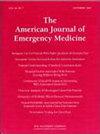Kinetic changes in high-sensitivity cardiac troponin for risk stratification of emergency department chest pain patients
IF 2.7
3区 医学
Q1 EMERGENCY MEDICINE
引用次数: 0
Abstract
Objective
Kinetic patterns of high-sensitivity cardiac troponin I (hs-cTnI) levels may provide prognostic value in chest pain patients. This study aimed to evaluate the association between these patterns and 30-day major adverse cardiac events (MACE).
Methods
A retrospective observational study was conducted, involving Emergency Department (ED) chest pain patients with at least two serial hs-cTnI measurements during their ED stay. Patients were categorized into three groups based on their hs-cTnI kinetic patterns: no change (delta hs-cTnI ≤15 ng/L), rising pattern (RP, delta hs-cTnI>15 ng/L), and falling pattern (FP, delta hs-cTnI>15 ng/L). Thirty-day MACE outcomes were compared across these groups. A stepwise multivariable logistic regression was utilized to evaluate the association of hs-cTnI patterns with 30-day MACE.
Results
This study included 4243 patients. No changes in hs-cTnI were observed in 3777 patients, with 136 (3.6 %) experiencing 30-day MACE. RP was identified in 294 patients, of whom 101 (34.4 %) experienced 30-day MACE, while FP was observed in 172 patients, with 25 (14.5 %) experiencing 30-day MACE. After adjusting for potential confounders, the adjusted odds ratio (AOR) for RP associated with 30-day MACE was 7.68 (95 % CI 5.34–11.05, p < 0.001) and the AOR for FP associated with 30-day MACE was 1.99 (95 % CI 1.14–3.48, p = 0.016).
Conclusions
Serial hs-cTnI measurements are valuable for identifying patients at risk for 30-day MACE, as both a RP and a FP in hs-cTnI levels are associated with a significantly increased risk of 30-day MACE.
求助全文
约1分钟内获得全文
求助全文
来源期刊
CiteScore
6.00
自引率
5.60%
发文量
730
审稿时长
42 days
期刊介绍:
A distinctive blend of practicality and scholarliness makes the American Journal of Emergency Medicine a key source for information on emergency medical care. Covering all activities concerned with emergency medicine, it is the journal to turn to for information to help increase the ability to understand, recognize and treat emergency conditions. Issues contain clinical articles, case reports, review articles, editorials, international notes, book reviews and more.

 求助内容:
求助内容: 应助结果提醒方式:
应助结果提醒方式:


